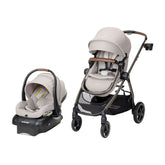How to Understand Your Baby's Cry & Handle It Effectively

Updated 26 Dec 2024
Crying is your infant’s only means of communication. It’s their way of signaling they need assistance when they’re uncomfortable or ready to eat. It helps them release tension. It also helps them block out any sensations or sounds that may be too intense for them. Some babies experience fussy periods that aren’t due to hunger, fatigue, or discomfort. They may be inconsolable at the time, and afterward, seem either calmer and more alert or deeply sleepy. Fussy crying is a way for some infants to release excess energy and feel more relaxed. As you and your little one get to know one another better, you may find that you’re able to hone in on the reason they’re crying. Whether they’re sleepy, bored, hungry, or hurting, each infant has a different way of crying to get their needs met.
How to Understand Why a Baby Is Crying: Types of Crying
A lot of times different types of cries coincide with one another. For example, very young infants typically wake up crying because they’re ready to eat. If a caregiver waits too long to respond, the baby’s whimpering may quickly escalate to screams of anger and frustration. Older babies tend to have noisier, more forceful, persistent cries. They also have a greater range with their cries as they learn to express varying wants and needs.
Myths About Crying: Should I Respond Every Time My Baby Cries?
Many people mistakenly believe that crying is good for newborns, but this simply isn’t true. Research shows that infants left to cry alone experience more tension and anxiety than those who are held and comforted. Not soothing your baby when they cry also prevents them from trusting you since you’re not making an effort to address their needs.
Another common myth is that crying fortifies a newborn’s lungs. However, there isn’t any proof of this. Infants who cry frequently don’t necessarily have greater lung capacity than calmer babies.
Others incorrectly believe that a baby crying sound is an attempt to manipulate you. This is false. Infants cry because they have a physical, social, or emotional need that’s not being met. They depend on their caregivers to help them. Knowing how to decode your baby’s cries will help you better meet their needs and help them feel safe.

How Do You Soothe a Crying Baby?
A prompt response is the best way to handle a crying baby, according to the American Academy of Pediatrics (AAP). It’s impossible to spoil a newborn with attention, and meeting their needs quickly means they’ll cry less in general.
It’s generally best to respond to your baby’s cries in order of priority. For instance, if your baby wakes during the night because they’re cold, hungry, and wet, warm them up, give them a dry diaper, and feed them. Does your little one’s cry sound piercing, shrill, or scared? They may be uncomfortable – perhaps their clothing is pinching them. If you’ve already made sure they’re warm, dry, and full but they still seem upset, there are a few soothing techniques you can try:
- Burping, in case gas pain is causing the distress
- Letting them feel gentle vibrations from a bouncer seat, a stroller ride, or a car ride
- Running white noise, like the humming of a loud fan or a white noise machine; sometimes even running a vacuum cleaner works wonders
- Playing soothing lullabies
- Singing or talking
- Swaying in your arms or rocking in a rocking chair
- Swaddling safely in a receiving blanket or a zippered swaddler
- Placing them in a warm bath
- Letting your baby suck on a pacifier or their hands
- Providing skin-to-skin contact
- Gently patting, touching, or massaging your baby’s skin
- Soothing them in a dark, quiet environment
- Holding your baby like a football, resting on their side
It’s also possible that if your baby is inconsolable, they may be sick. Check their temperature. If you take it rectally and it is 100.4 degrees Fahrenheit (38 degrees Celsius) or higher in a newborn, it’s possible they could have an infection. Contact your pediatrician immediately.

My Baby Won't Stop Crying and I've Tried Everything: What to Do When Nothing Seems to Work
When nothing seems to soothe or comfort your little one, sometimes the best approach is to place your baby on their back in a safe place like their crib and step aside for a few moments. Some infants need to cry themselves to sleep and will do so more quickly if left alone for a bit. If they’re truly tired, the crying won’t last long.
On the other hand, if the crying becomes more persistent and lasts for extended periods of time, your baby may be experiencing colic or the PURPLE crying period. Most babies who experience persistent crying are healthy and thriving. This phase usually improves by the time the baby is 12 to 16 weeks old. In some babies, persistent crying is related to problems with digestion. If you believe your baby may have digestion pain, make an appointment with your pediatrician.Other persistent criers have exceptionally sensitive or underdeveloped nervous systems. Try to identify any excessive stimulation in your infant’s environment and eliminate it. The Period of PURPLE Crying is a program designed by leading experts on infant crying and the National Center on Shaken Baby Syndrome. It offers detailed information on why babies cry and tips for soothing them. For more information, visit purplecrying.info.
The calmer a caregiver or parent remains, the easier it will be for them to soothe the child. Even newborns can pick up on stress and respond to it by crying. Listening to a screaming baby can be excruciating, but allowing your desperation to turn to rage or fear will only amplify your baby's screams.
Parents and Caregivers: Take a Time-Out If Needed
If you begin to feel overwhelmed, the best course of action is to place your baby in a safe place and get assistance from a partner, friend, or another family member. This will allow you to step away, regroup, and calm yourself. Sometimes seeing a new face can even help surprise and settle your little one. Regardless of how upset you’re feeling, it’s never okay to shake or hit your baby. Doing so can result in brain damage, blindness, or even death.
The Bottom Line on Understanding Your Baby's Criees
The most important thing to keep in mind is that your baby’s crying is not a personal attack on you (though it may sometimes feel like it). Babies don’t cry because they think you're incompetent or because they dislike you. All infants cry, and it’s frequently without any obvious trigger. In fact, newborns regularly cry between one to four hours daily. It’s simply the next phase in adapting to life after birth. No caregiver or parent can soothe their child every single time they’re upset. Give yourself some grace if you’re struggling and try to adopt a more down-to-earth philosophy. Enlist help, rest as much as possible, and try to appreciate all those other tender moments with your little one.










